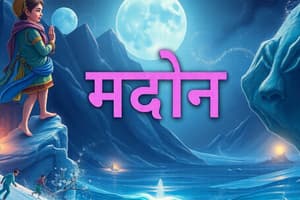Podcast
Questions and Answers
Which of the following statements best describes the relationship between Hindi and Hindustani?
Which of the following statements best describes the relationship between Hindi and Hindustani?
- Hindi is often described as a standardized and Sanskritised register of the Hindustani language. (correct)
- Hindustani serves as the ancient liturgical form of Hindi, akin to Latin's role in relation to Romance languages.
- Hindi and Hindustani are unrelated languages with distinct origins and grammatical structures.
- Hindustani is a modern simplified version of Hindi, primarily for international communication.
What is the significance of Khariboli in the context of Hindi language development?
What is the significance of Khariboli in the context of Hindi language development?
- Khariboli forms the basis for Modern Standard Hindi, particularly in terms of its dialectal foundation. (correct)
- Khariboli represents a wholly distinct language family, separate from Indo-Aryan languages.
- Khariboli is an ancient script used exclusively for religious texts in Hindi.
- Khariboli serves as a dialect used by traders and merchants, with no influence on the formal Hindi.
Which script is employed for writing Hindi, and what distinguishes it as an abugida?
Which script is employed for writing Hindi, and what distinguishes it as an abugida?
- Devanagari script, where vowels are inherent in consonants but can be altered or suppressed with diacritics. (correct)
- Greek script which is adapted due to its simple linear structure and consistent vowel representation.
- Perso-Arabic script, recognized by its fully phonetic representation of each sound.
- ব্রাহ্মi script, an alphabet where each symbol represents a consonant and requires modification marks for each vowel.
How does the standardization of Hindi in the 20th century affect its vocabulary?
How does the standardization of Hindi in the 20th century affect its vocabulary?
What is a key difference between Hindi and Urdu, despite both being considered registers of Hindustani?
What is a key difference between Hindi and Urdu, despite both being considered registers of Hindustani?
If you are translating a sentence into Hindi, and the English sentence structure is Subject-Verb-Object (SVO), how would you typically structure the Hindi sentence?
If you are translating a sentence into Hindi, and the English sentence structure is Subject-Verb-Object (SVO), how would you typically structure the Hindi sentence?
Which of the following factors contributes to the complex relationship surrounding Hindi as a national language in India?
Which of the following factors contributes to the complex relationship surrounding Hindi as a national language in India?
What characterizes the modification of verbs in Hindi?
What characterizes the modification of verbs in Hindi?
Flashcards
What is Hindi?
What is Hindi?
An Indo-Aryan language, the official language of the Union government of India, and one of the 22 scheduled languages of India.
Hindi's Origin
Hindi's Origin
A standardized and Sanskritised register of the Hindustani language, based on the Khariboli dialect of Delhi.
Devanagari script
Devanagari script
An abugida writing system where vowels are inherent in consonants but can be altered or suppressed with diacritics.
Hindi Belt
Hindi Belt
Signup and view all the flashcards
Hindi's Influences
Hindi's Influences
Signup and view all the flashcards
Hindi Standardization
Hindi Standardization
Signup and view all the flashcards
Hindi vs. Urdu
Hindi vs. Urdu
Signup and view all the flashcards
Hindi Word Order
Hindi Word Order
Signup and view all the flashcards
Study Notes
- An Indo-Aryan language, Hindi is spoken mainly in India.
- Hindi serves as the official language of the Union government of India.
- It is recognized as one of the 22 scheduled languages of India.
- Often described as a standardized and Sanskritised form of Hindustani.
- The foundation of Hindustani is the Khariboli dialect of Delhi and surrounding North Indian regions.
- Hindi's origins trace back to early Prakrit languages.
- Evolved from Apabhramsa, a transitional phase of Prakrit.
- Modern Standard Hindi is rooted in the Khariboli dialect.
- The Devanagari script is used to write Hindi.
- Devanagari is an abugida, where vowels are inherent in consonants but can be altered or suppressed with diacritics
- Hindi is widely used in the Hindi Belt of North and Central India.
- A significant diaspora population speaks Hindi or closely related dialects outside of India.
- These countries include Nepal, Fiji, Mauritius, and South Africa, among others.
- Its linguistic development includes influences and vocabulary from Sanskrit, Prakrit, Persian, Arabic, and English.
- The standardization of Hindi took place mainly in the 20th century.
- Khariboli was promoted and the use of Sanskrit-derived vocabulary was increased during standardization.
- Plays an important role in Indian culture through its literature, cinema (Bollywood), music, and media.
- Governmental and non-governmental organizations support the promotion of Hindi.
- The role of Hindi as a national language is a topic of debate in India
- The complex relationship between Hindi and Urdu; both are considered registers of the Hindustani language.
- Hindi usually incorporates vocabulary from Sanskrit, while Urdu often uses words of Persian and Arabic origin.
- Hindi grammar is largely derived from Sanskrit and Prakrit, with complex noun-verb agreement.
- The typical word order in Hindi sentences is Subject-Object-Verb (SOV).
- Postpositions, similar to English prepositions, follow the nouns they govern.
- Hindi verbs are conjugated based on tense, aspect, mood, gender, and number.
- A rich history exists in Hindi literature, including poetry, prose, drama, and other forms of writing.
- Modern Hindi literature addresses current social, political, and cultural issues.
- Hindi cinema, known as Bollywood, is a major part of Indian entertainment.
- Bollywood films have a broad distribution and international audiences.
- Many songs in Bollywood films are in Hindi.
- An understanding of Indian culture, media, and society is improved by knowledge of Hindi.
- Second-language Hindi instruction is provided in numerous schools in India and worldwide.
- Various resources are available for learning Hindi, including textbooks, online courses, language exchange partners, and immersion programs.
- Continues to evolve, with new words and expressions constantly being added.
- It reflects India's changing social and technological environment.
- Proficiency in Hindi can lead to job opportunities in translation, interpretation, journalism, teaching, and tourism.
- Concerns exist regarding maintaining linguistic diversity and avoiding the imposition of Hindi on non-Hindi speakers.
Studying That Suits You
Use AI to generate personalized quizzes and flashcards to suit your learning preferences.




